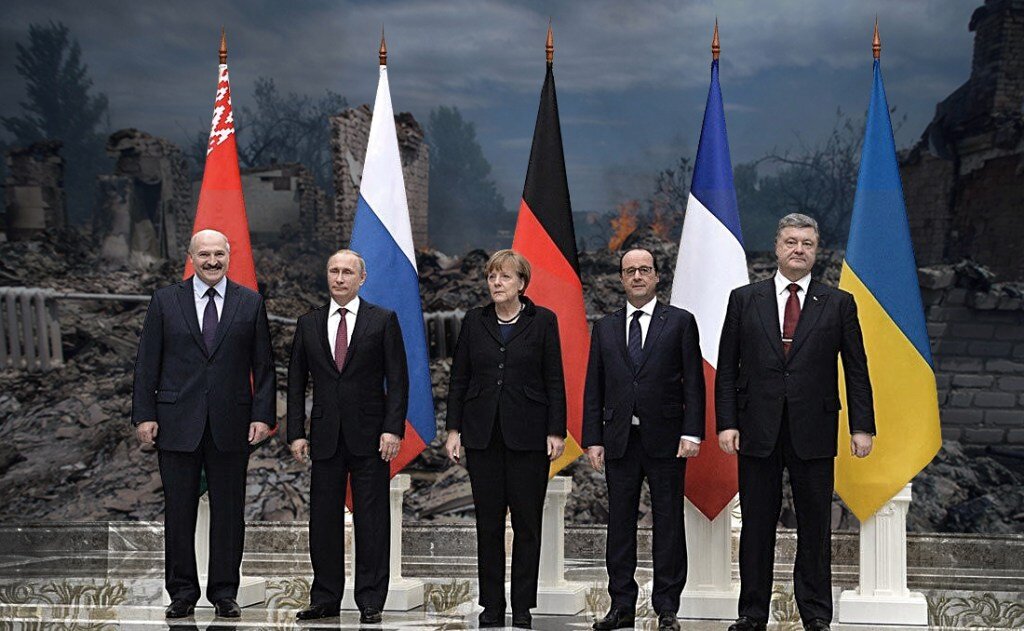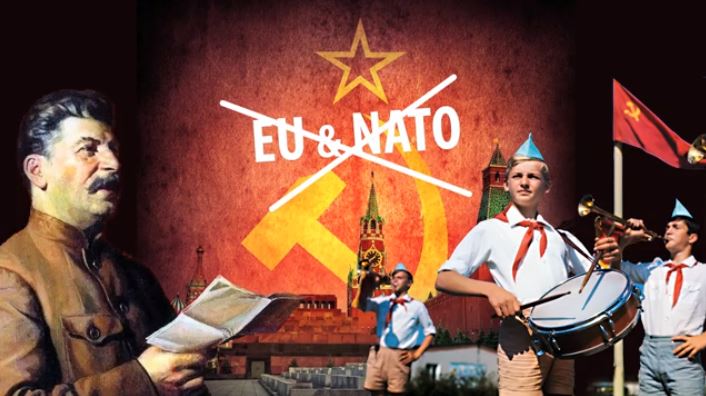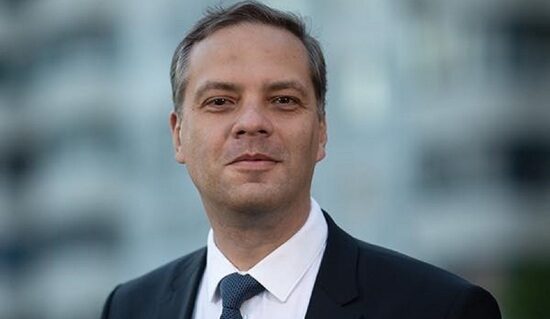What's happening?
US Defense Secretary Pete Hegseth just declared that any peace deal with Russia “cannot be Minsk 3.0” while simultaneously calling Ukraine’s pre-2014 borders “unrealistic” and ruling out NATO membership. These are exactly the conditions that made the Minsk agreements a trap for Ukraine.
Simultaneously, Donald Trump spoke with Vladimir Putin about “ending the deaths in Ukraine.” Then Trump immediately refused to recognize Ukraine as an equal participant in peace talks and suggested Ukraine should give up territory. Putin seems surprisingly eager to negotiate – Russian and US envoys are lining up their ducks for talks in Saudi Arabia about Ukraine, without Ukraine at the table.
This has experts very worried.
Trump says he can end the war in 24 hours. What's wrong with that?
If only. Unfortunately, Russia uses peace negotiations as weapons of war.
This isn’t speculation – we know this from leaked emails of Putin’s advisor Vladislav Surkov from the Minsk peace talks in 2015. These documents reveal how Russia turned seemingly reasonable peace proposals a trap that prepared Russia for full-scale invasion in 2022.
Peace talks that led to full invasion: how did that happen?
Think of it like a chess game where one player keeps offering a “draw” – but only after capturing your pieces and positioning for a better attack. This is exactly what Russia does, through what military analysts call “escalation dominance.”
Let’s see how this worked with Minsk:
In February 2014, Ukraine toppled a Russian-backed dictator during the Euromaidan revolution. Russia responded by occupying Crimea with “little green men” — soldiers without insignia. Then Russia fueled a war in eastern Ukraine using irregular forces like the Wagner private military company, creating puppet “republics” to maintain deniability.
But by June 2014, Ukraine started winning. President Poroshenko sent Russia a detailed peace plan that could have quickly resolved the conflict: clear steps for demilitarization and local governance.
Russia’s response? Invading Ukraine with the regular Russian army. In August 2014, Russian troops trapped Ukrainian units at Ilovaisk, executing many Ukrainian soldiers who had been promised safe passage. This massacre forced Ukraine to accept Minsk-1 – an agreement weaker than Poroshenko’s original plan.
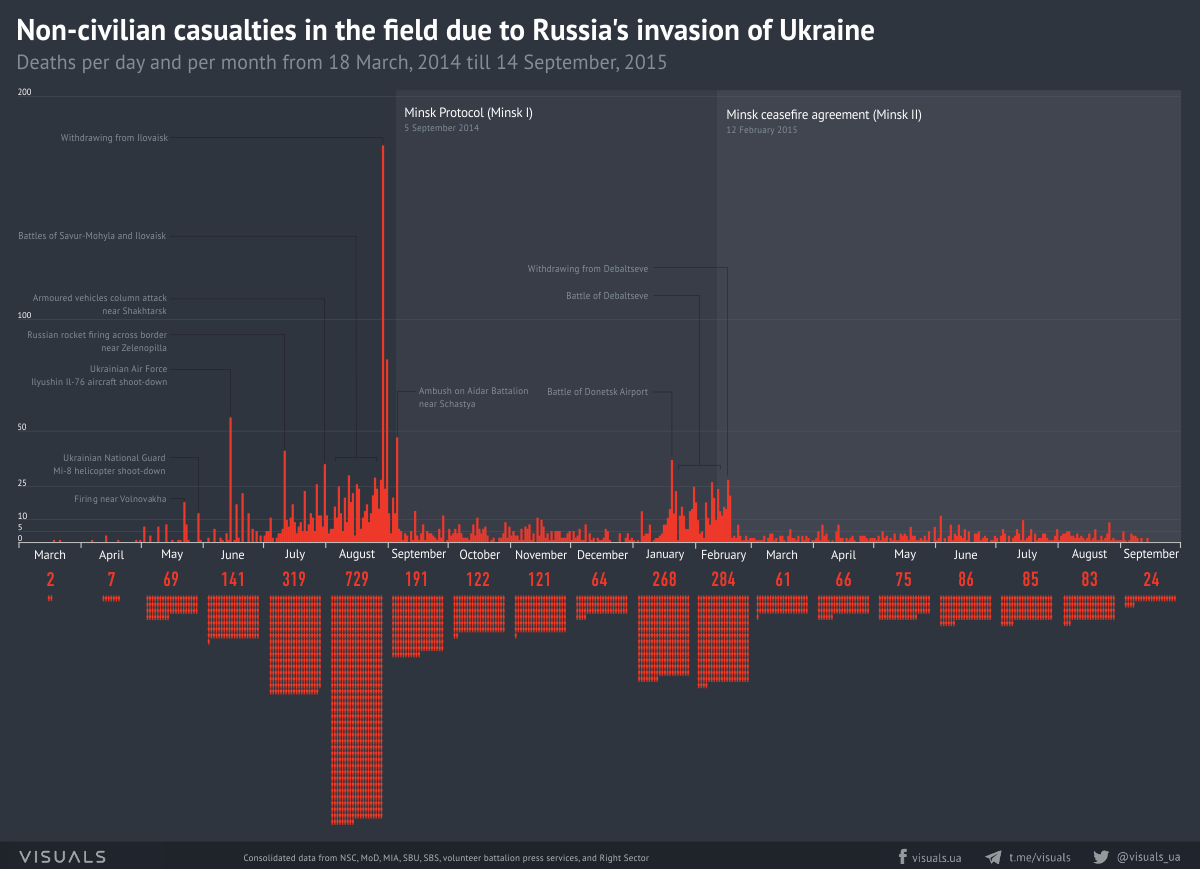
When Minsk-1 still left too much room for genuine peace, Russia systematically violated the ceasefire. Then in January 2015, Russia launched a massive offensive at Debaltseve, using this military pressure to force an even worse deal: Minsk-2.
Minsk-2 contained none of Poroshenko’s quick conflict resolution measures. Instead, it contained provisions to legitimize Russia’s puppet “republics,” with Ukraine footing the bill and permanently enshrining this Russian enclave in Ukraine’s constitution.
It was a strategy to create a zone of permanent conflict and Russian influence, moving toward Russia’s final goal – dominance over Ukraine and resurrecting its empire.
How do we know this was Russia's strategy?
Through Surkov Leaks, the leaked emails from Putin’s 2014 advisor Vladisla Surkov. Published by Ukrainian hackers, they revealed Russia’s strategy of embedding “Trojan horses” in peace deals.
The emails detail how seemingly standard diplomatic language was designed to create mechanisms for Russian control. Russia created puppet statelets in eastern Ukraine, passed them away as independent entities (“ORDLO”), and through Minsk-2 sought to give them formal status in Ukraine’s constitution — a step towards its goal of torpedoing Ukraine’s western ambitions by forcing it to federalization.
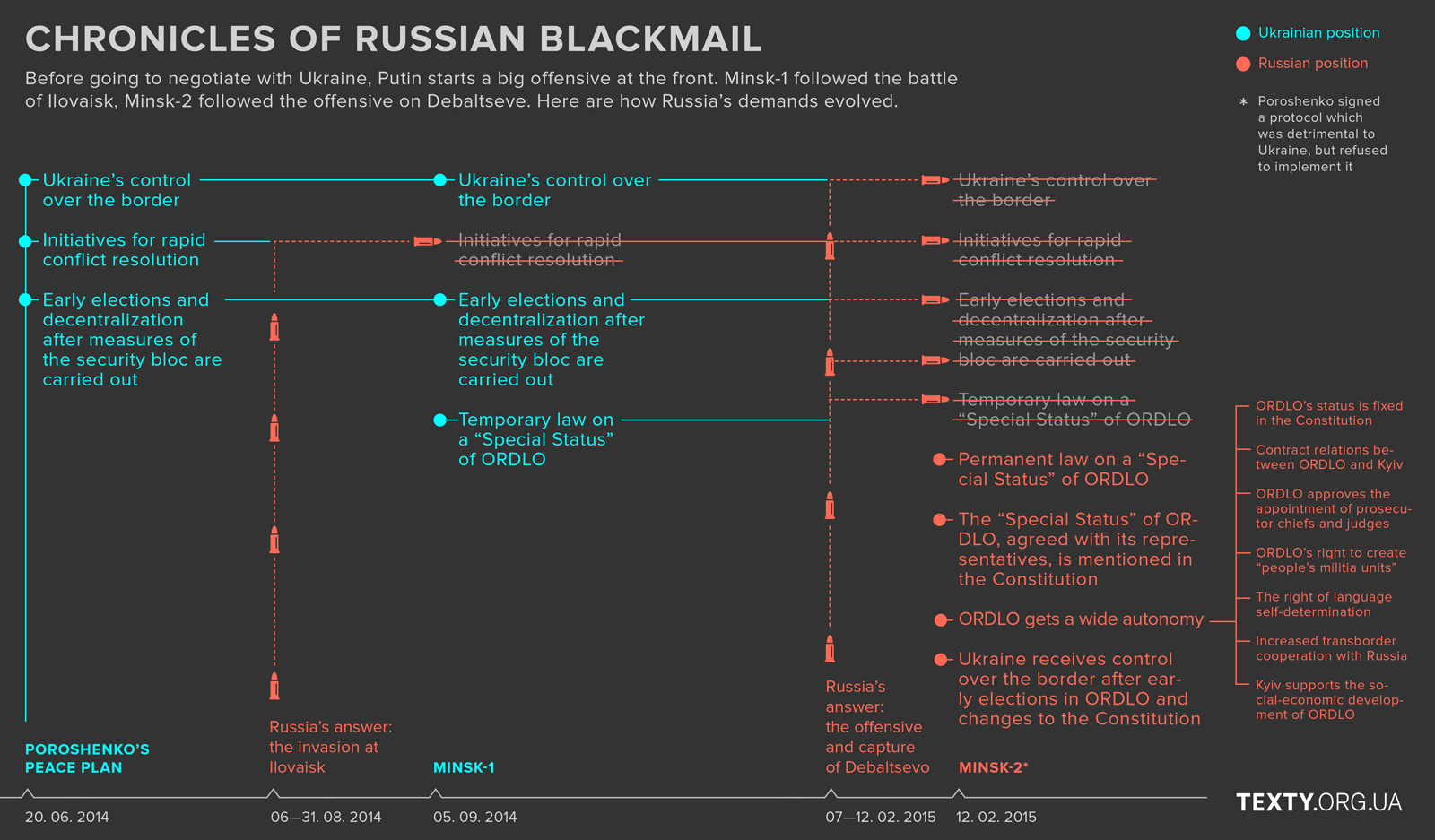
However, Ukraine rejected this bidding, adopting only a temporary law for Russia’s enclaves (ORDLO in the infographic above). Russia then opted for freezing the conflict: it could be “unfrozen” at any time to prevent Ukraine from joining NATO and would allow insisting on federalization, a think-tank told Surkov.
The admission came in 2024: Surkov openly declared that Minsk-2 “legitimized the first partition of Ukraine” and that “peace is nothing more than the continuation of war by other means.”
Seven years of "peace talks" - then full invasion. What really happened?
The appearance of a peace process served Russia’s strategic goals. But a classified 2019 defense report seen by Euromaidan Press warned Ukraine’s government of Moscow’s true objectives:
- full occupation of Ukraine
- installation of a puppet regime in Kyiv
- and division of the country into weak pro-Russian entities.
The mechanism was sophisticated: Russia would present its invasion as an internal Ukrainian conflict while posing as a mediator. Then it would create conditions impossible for Ukraine to fulfill, blame Ukraine for “spoiling peace” by refusing to surrender, and use this as justification to maintain control while preparing for larger aggression.
After 2014, leaked documents show Russia pursuing two parallel strategies.
- Covert political warfare, revealed in detail through the Surkov leaks. Putin’s advisor coordinated a network of bribed politicians, puppet NGOs, and media assets. He even planned to break off additional Ukrainian regions using Russian troops stationed in Transnistria
- Diplomatic warfare through Minsk-2 itself. Russia attempted to turn its puppet enclaves into a permanent “Trojan horse” within Ukraine. The key demand: Ukraine must hold elections in occupied territories before Russian troops withdrew, giving Moscow’s proxies veto power over Ukraine’s foreign policy. Ukraine consistently demanded the opposite sequence: security and Russian withdrawal must come before any elections.
However, Russia made two crucial miscalculations.
- Russia hoped Western sanctions fatigue would force Ukraine to accept these terms, underestimating Western resolve.
- Instead, Ukraine convinced its partners that security must come first (while attempting to find a way to escape Minsk-2).
- Russia bet that Ukraine’s new president Zelenskyy would be more pliable than Poroshenko.
- However, as one Minsk participant revealed, Zelenskyy also refused to surrender sovereignty, and the talks essentially stopped in 2019.
Meanwhile, Russia used this “frozen conflict” period to prepare for full-scale invasion. The same 2019 classified defense report warned that Russia had developed the capability to launch surprise strikes 400 kilometers deep into Ukraine using 120 missiles – a capability it would use in 2022.
Why did Western leaders accept this deal, if it was so bad?
Three key factors made the trap work:
1. Military pressure through timing: Russia deliberately launched offensives before peace talks. Military records show major escalations preceded both Minsk agreements – Ilovaisk before Minsk-1 and Debaltseve before Minsk-2. This created artificial urgency for any ceasefire.
2. Nuclear blackmail: Insiders reveal that Russia used nuclear threats in discussions with German Chancellor Merkel. This pressure led Western leaders to push Ukraine toward “realistic compromises” — a euphemism for accepting Russian demands.
3. Western business interests. In the words of ISW researcher Nataliya Bugayova, Minsk-2 gave an excuse to those who understood the Kremlin’s goals but sought to restore ties with Russia anyway.
4. Fundamental misunderstanding. Like Trump today, Western leaders believed:
- Putin might settle for limited territorial gains
- Keeping Ukraine out of NATO would satisfy Russian security concerns
- Personal diplomacy with Putin could achieve better terms
These assessments missed Russia’s larger strategic goal: using peace talks to prepare for bigger wars.
Are you saying that Russia’s Minsk-2 peace talks were actually a weapon of war?
Exactly! The peace talks were a crucial part of what military analysts call Russia’s “escalation dominance” – a systematic pattern of using each “peace” to prepare for bigger wars.
- The first cycle began in 2014-2015 with the “green men” in Crimea.
- When that operation succeeded, Russia escalated to war in Donbas.
- After forcing Ukraine to accept Minsk-1, Russia used the pause to regroup, then escalated again to force the worse terms of Minsk-2.
- During this “peacetime,” Russia methodically transformed each occupied area into a military base.
The 2015-2022 cycle showed even more strategic patience.
While Minsk-2 kept Ukraine out of NATO, Russia systematically built up its military capabilities.
Each “frozen” conflict zone became a fortress:
- Crimea transformed into a massive military base,
- Donbas got extensive fortifications,
- and Belarus began hosting Russian forces.
All these positions, built during “peace,” became launching points for the 2022 invasion.
Now in 2022-2025, after the massive invasion attempt, Russia is again calling for “realistic” peace while preparing for broader confrontation.
Military analysts warn that what Russia builds during “peace” becomes its springboard for the next war.
Just give Putin what he wants and end this - what's the worst that could happen?
That’s exactly what Western leaders said in 2015. They gave Putin what he wanted in the Minsk agreements – and he used that “peace” to prepare for full invasion. Now military analysts warn the same pattern is repeating, but with far higher stakes for the West.
The thing is, each concession has expanded Russia’s ambitions.
What began in 2014 as an attempt to control parts of Ukraine evolved by 2022 into a bid to destroy Ukrainian statehood entirely.
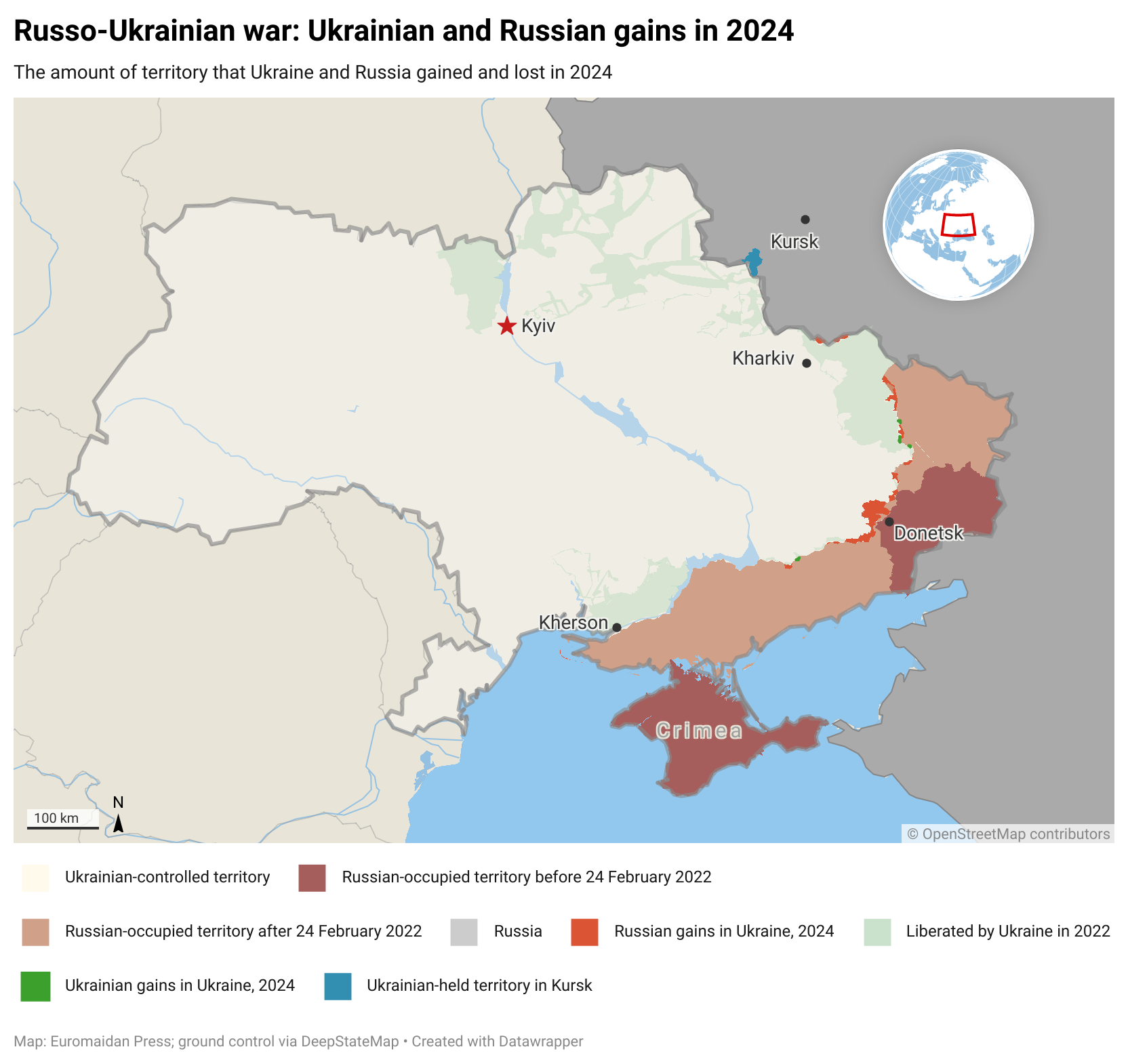
Now in 2025, according to Danish intelligence, Putin could be preparing for a full-scale European war within five years – emboldened by every “peace” deal that rewarded aggression.
The current US-Russia framework would repeat the pattern, but this time, the stakes are higher than in 2015:
- Russia emerges from Ukraine with a battle-tested military experienced against NATO weapons, strengthened ties with China, Iran, and North Korea, and over 500,000 mobilized troops needing new targets.
- The economic price tag if Ukraine falls? A staggering $400–500 billion in additional US defense spending annually, doubled European defense budgets, and massive reconstruction costs shifted from Russia to Western taxpayers.
- Most dangerously, a weak peace deal would demonstrate that aggression and nuclear blackmail work. This would encourage similar actions by other powers, like China regarding Taiwan, while undermining the post-WWII international order.
The result? A more dangerous world where future wars become increasingly likely, coming with skyrocketing defense costs.
OK, so what do you propose?
Military history shows that peace talks become meaningful only when an aggressor is forced to recognize failure. This isn’t theoretical – we can see it in Russia’s own behavior.
When faced with sufficient force, Russia does adjust to new realities.
- In 2022, Russian forces retreated from Kyiv when their advance failed.
- They withdrew from Kherson after claiming it would be “Russian forever.”
- Even more striking, Moscow has accepted Ukrainian military operations in Russia’s own Kursk Oblast – the first foreign military presence there since World War II.
Each time, these changes came through military facts on the ground, not diplomatic concessions.
- Each occupied territory that Ukraine was asked to accept “temporarily” became a military base;
- Each pause in fighting gave Russian forces time to regroup;
- Most importantly, each Western hesitation to provide military support was read in Moscow as encouragement to demand more.
Security experts have identified clear requirements for lasting peace based on historical precedent:
- Borders must be restored to their internationally recognized lines. This isn’t just about territory – it’s about establishing that conquest doesn’t pay.
- Russia must bear the cost of reconstruction, creating real consequences for military aggression.
- Any Russian withdrawal must be verified, not just promised.
- Ukraine needs concrete security guarantees backed by military capability, not just diplomatic assurances.
The evidence from conflicts worldwide shows that negotiating with an aggressor who denies your right to exist leads to bigger wars. The path to real peace isn’t through rewarding aggression with concessions, but through making the cost of aggression unbearable.
Come on Ukraine, that’s not realistic. Russia is just too big and strong. Plus, it has nukes.
Russia sure wants you to think that, just like it wanted the West to think that Minsk-2 is the only solution to the war it engineered.
But in fact, Russia is far from invincible – it has lost four major wars in the last 170 years. And Ukraine has done wonders repelling the Russians against all odds.
However, Russia is simply spending more on the war. Despite being 35 times richer than Russia, Ukraine’s NATO allies are spending, in relative terms, ten times less on helping Ukraine resist Russia’s invasion than North Korea and Iran are spending on helping Russia destroy Ukraine, the Tony Blair Foundation has found.
Just an additional 0.2% of the GDP of European NATO members would even the odds, the foundation says. This is a tiny fraction of what they would be forced to spend on defense if Russia gets its way and sets up a new Cold War!
Moreover, Russia is running out of its Soviet-era equipment. It is running out of money – Russia’s ex-energy chief warns that Russia faces economic collapse in 2025 if it doesn’t stop the war.
Regarding the nukes – just check out this graph. Nuclear blackmail is Russia’s greatest weapon – but it’s all a bluff. Ukraine crosses the “red lines” daily and Russia pretends it doesn’t see.
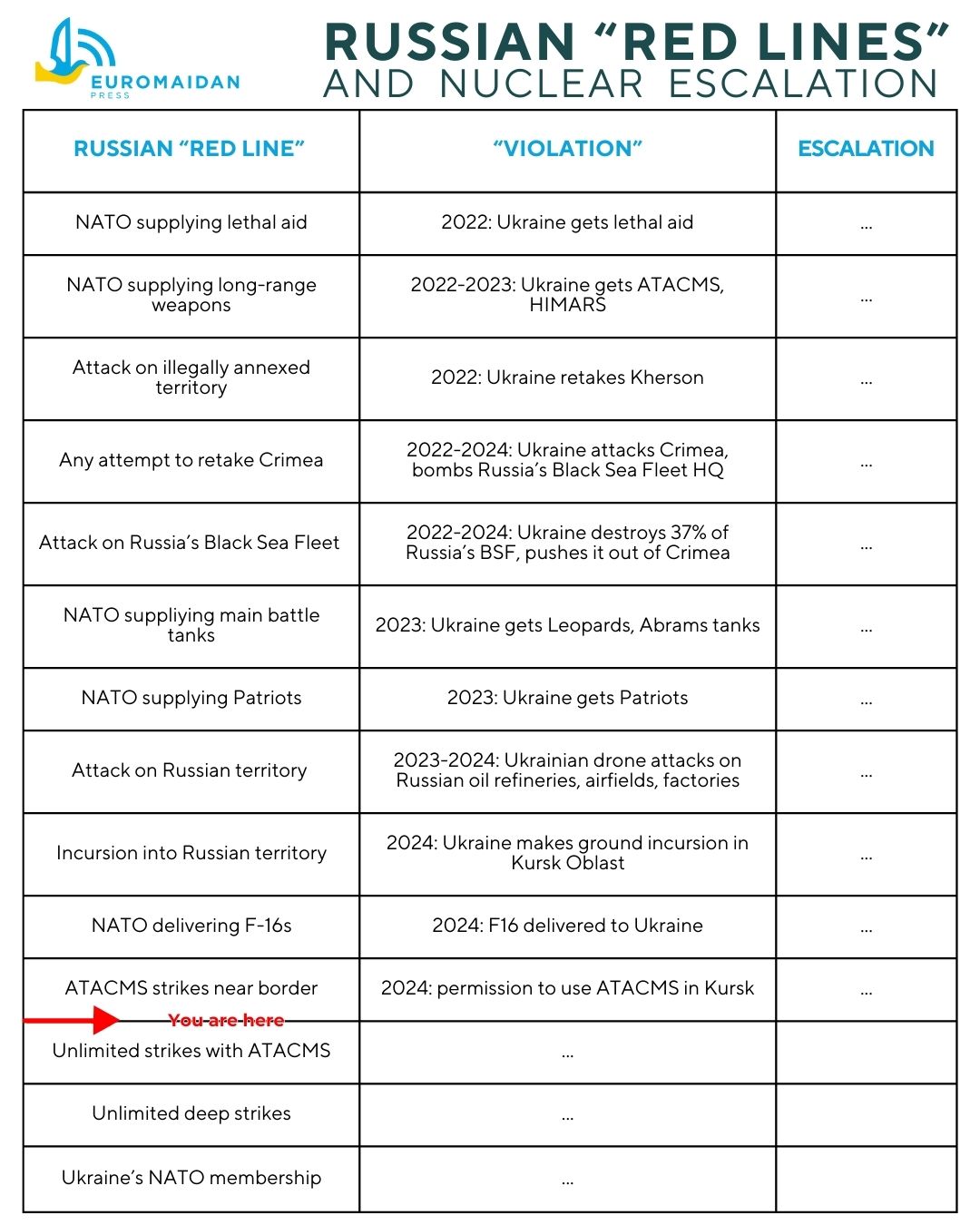
What's the bottom line?
The choice isn’t between war and peace – it’s between stopping Russia’s pattern of using “peace” to prepare for war, or facing an even bigger, more expensive, and deadly conflict later. Russia will stop when it sees it cannot take Ukraine – and the West must show it is resolute.
The evidence from Minsk to today shows we can have either real peace or another Russian trap. We cannot have both.

The world keeps wishing Russian aggression away.
But we at Euromaidan Press know first-hand that Russia needs resistance, not appeasement -- and now, you can be the force that drives our mission.
Stop watching history. Create it — become our patron right now.

